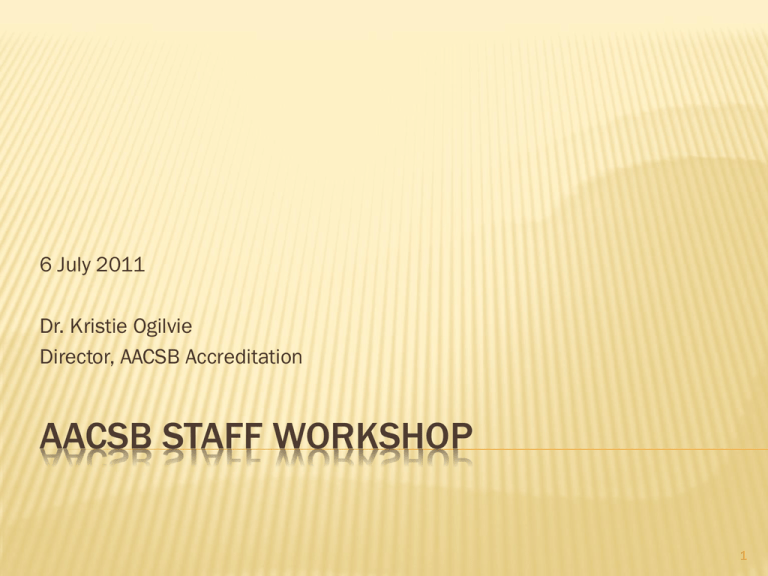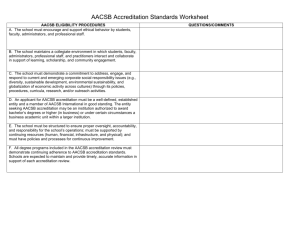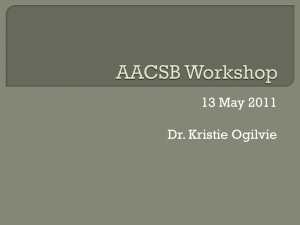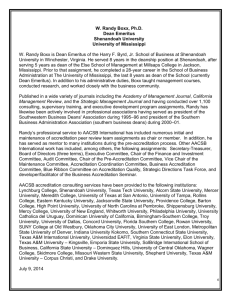AACSB Informational Workshop - College of Business and Public
advertisement

6 July 2011 Dr. Kristie Ogilvie Director, AACSB Accreditation AACSB STAFF WORKSHOP 1 How can I make a difference? What am I doing here? What value do I bring? Why am I important to Accreditation? What do I need to know for my job? 2 WHO AM I AND WHY AM I HERE? Who am I? Industry: Aerospace / Pharma, 10+ Years. Teaching: CSUS, Chapman, CSUF, CSUSB (Marketing) Management Professor in the CBPA. Teacher: MGMT 302, 335, 455, 601, 665, 641, 642. Research: SNA, Teams, Technical Workforces. Grant Writer Service Director, AACSB accreditation Chair of the UG AoL committee historically. 7/9 Faculty = Research and Teaching Why am I here? Focus on staff is a necessity. Focus on quality is a necessity. Are staff a Problem area? No, but we need to leverage our strengths. 3 AGENDA Introduction to Accreditation / AACSB AACSB Accreditation Strategy / Mission Faculty Qualifications Assurance of Learning Recent Trends and Future Actions Second Half of Workshop Outline and Objectives 4 WHAT IS ACCREDITATION Standard of quality, emphasis differs. Regional: Teaching Related Professional : Teaching and Research Relation Different disciplines have different accrediting bodies US and European Accreditation for Business AACSB (US) EQUIS (European, though Bentley & Babson in US) AMBA (Europe, founded by Harvard & 7 UK schools) 50 Schools Worldwide have Triple Crown (None in US)* Our Accreditation Bodies CSUSB – WASC, CBPA – AACSB, PA - NASPAA 5 PRESENTATION STRUCTURE AND NOTATIONS Standards – No Notation ICAM 2011 – Annual Conference BPAV 2011 - Best Practices from Accreditation Visits MOA 2011 – Maintenance of Accreditation Conference AAS 2010 - Applied Assessment Seminar USW 2009 - Updated Standards Webinar 6 CBPA STRUCTURE Dean AACSB Accreditation Strat. Plan. Com (Faculty) Dean Director of Accreditation (Ogilvie) Analyst (Flynn) ASC – Varied based on Task Strategy / Mission Faculty Qualifications Standard 1-15 AQ/PQ Graduate Courses Digital Measures Publication Quality Standard 2, 9, 10* Assurance of Learning Undergraduate Graduate MSA Offsite & Online Standards 16-21* *Focus of Interim Report , 5th Year Report and Visit Documentation Liaison: 1. AACSB Contact 2. University Relations Milestones: 1. Interim Report 2. 5th Year Report 3. On Site Visitation 7 AACSB MISSIONS Advanced quality management education worldwide through…… Accreditation . . Thought Leadership Value Added Services 8 AACSB, AN INTRODUCTION AACSB was established in 1916. Headquarters in Tampa, Florida. Accreditation is awarded base on 21 standards. made at the institutional level. is awarded in business, accounting, or both. awarded to less than 10% of Business Schools Worldwide. Accredited Institutions In 2011, 694 total, 620 in North America In Process 184 – Mostly International. 9 STANDARDS Standards Description of requirements Less information on the “how to” Interpretive material provided as a supplement Conferences, seminars, webinars, whitepapers cover acceptable and best practices. Mission / Strategy - Standard 1-5 Faculty Qualifications - Standard 6-15 Assurance of Learning - Standard 16-21 10 AACSB REPORTING CYCLE Initial accreditation must cover all standards Maintenance of accreditation covers the areas of weakness from last 5 year visit Upon initial accreditation an interim report is due 2.5 years (July 2011) Every five years, a visit occurs in which a full report is due. Documentation key. and Interview of faculty and staff is 11 Mission and Strategy SECTION 1 12 AACSB ACCREDITATION: MISSION / STRATEGY A school articulates its mission and action items as a guide to its view of the future, planned evolution, infrastructure, and use of resources. The strategic management standards verify that a school focuses its resources and efforts toward a defined mission as embodied in a mission statement. What is the overall mission to your organization? How are resources deployed to support your mission? How are your programs deployed to support your mission? Profit / financial incentive is not enough of a reason for deployment. (BPAV 2011) 13 FACULTY CONTRIBUTION TO STRATEGIC FRAMEWORK Strategic Plan Managed through strategic planning committee Re-engergized in 2011-2012 with Dr. Mike Stull as Chair. Primarily teaching based mission Diverse student base Areas for Concentration Deployment of programs: MSA, Online MBA, International Partnerships Institutional accreditation Excluding programs from accreditation If 25% or more of the program is taught by business faculty, it can not typically be excluded Economics and International 14 STAFF CONTRIBUTION TO STRATEGY/MISSION Standard 4 – Continuous Improvement Processes are continually improved to continue to fulfill mission. Documented Processes and Action Items Standard 5 – Financial Costs vs. Resources carefully examined Infrastructure fits activities: labs, classrooms, offices, communications, computer equipment, communication, basic facilities and processes The key is to obtain data, track data, and base change from data. 15 Faculty Qualifications SECTION 2 16 FACULTY QUALIFICATIONS: DEFINED A direct link exists between: a school’s mission the characteristics of students served by the educational programs the composition and qualifications of the faculty members providing the programs the overall quality of the school. 17 FACULTY QUALIFICATIONS: ACADEMIC A clear policy must be in place that delineates AQ / PQ criteria. Documentation must be maintained to substantiate the status designation in a portfolio. PRJs are universally required, though other ICs are expanding (MOC, 2011) 18 FACULTY QUALIFICATIONS: AQ/PQ RATIOS At least 90-percent of faculty resources are either academically or professionally qualified. At least 50-percent of faculty resources are academically qualified. Trends (ICAM, 2011) AQ PQ 2002-2003 73% 22% 2009-2010 63% 30% . 19 FACULTY QUALIFICATIONS: AQ REQUIREMENTS To be AQ, one must hold a doctorate degree Non-AACSB schools or programs may be questioned, in which a portfolio of ICs must be provided (ICAM, 2011) Recent graduates receive a 5 year window to reach AQ standards PhD students have 3 years to reach their graduation once ABD status is met IC policy set by school and compared to peers. (ICAM, 2011) 20 FACULTY QUALIFICATIONS: PROFESSIONAL Normally, the professional experience should be relevant to the faculty member's teaching assignment, significant in duration and level of responsibility, and current at the time of hiring. Once hired, the PQ status is granted for a five year period. If the duration of employment is over five years, a portfolio of continued professional activity must be maintained. 21 PARTICIPATING VERSUS SUPPORTING Regardless of the type of contractual relationships between faculty members and the school, the faculty is sufficient in numbers and presence to perform or oversee the following functions: Curriculum Development Course Development Other activities that support the instructional goals of the school's mission, such as faculty development activities, community service, institutional service, service in academic organizations, economic development. 22 FACULTY QUALIFICATIONS: PQ RATIOS Participating faculty members will deliver at least 75-percent of the school's teaching (whether measured by credit hours, contact hours, or other metric appropriate to the school). Normally, Participating faculty members will deliver at least 60-percent of the teaching in each discipline, each academic program, and location. 23 FACULTY QUALIFICATIONS Ratios must be tracked and reported in each discipline, each academic program, and location. A single dip in ratios does not jeopardize accreditation, though corrective action must be reported and taken. 24 CSUSB’S STRATEGY FOR FACULTY QUALIFICATIONS Policy Defined: AQ/PQ, Graduate Teaching and P/S Update of Digital Measures Necessary Area of Concentration Recent trends issues (ICAM 2011) Vitas matching database and tables Non-AACSB Doctorates PhD Students Incentive programs underway for: AQ and Research Research Quality High Quality Research 25 Assurance of Learning SECTION 3 26 ASSURANCE OF LEARNING Student learning is the central activity of higher education. Definition of learning expectations and assurance that graduates achieve learning expectations are key features of any academic program. The learning expectations derive from a balance of internal and external contributions to the definition of educational goals. Learning goals should be set and revised at a level that encourages continuous improvement in educational programs. 27 ASSURANCE OF LEARNING: DEFINITION Assurance of Learning Framework Create learning goals that reflect the outcomes that an institution wants students to obtain upon graduation. Assess student learning, based on those learning goals. Analyze and report results of the data from the assessment process to the stakeholders. Drive change for continuous improvement from the assessment program. – “Closing the loop”. 28 ASSURANCE OF LEARNING AACSB states accredited schools must illustrate a mature system for collecting and assessing data for maintaining accreditation, outlined from the AACSB standards. “For schools with visit years in 2007-08 and beyond, the impact of assessment outcomes on continuing development of degree programs should be evident.” (AACSB 2011, p. 69) 29 WHAT IS A ‘MATURE’ FRAMEWORK?*** Methodology is sound (reliable and valid) Established and well thought out learning goals No group data Mature rubrics for assessment and rater reliability Not a major concern, except if shows to be an issue (such as no improvement necessary for a majority of learning goals) Assessment Course selection Portfolios / Comps No selection bias (population / e-portfolios) Faculty driven Data drives change in curriculum Issues discussed in “recent trends” Does not exclude any set of students that makeup the program Consistency between courses for multi course sample (i.e. PA 315) Mounds of data, does not drive change and improvements of curriculum *** Accumulation of discussions from seminars/conferences 30 ASSURANCE OF LEARNING: LEARNING GOALS Universal Skills that all students should possess through development in their program upon graduation Four to six recommended. Goals can vary per program “Less is more... assess four learning goals well, rather than six with less quality” (Trapnell, MOC 2011) Examples from AACSB Material Leadership, Globalism, Teamwork, Information Technology, Oral Communication, Written Communication, Ethical Reasoning, Problem Solving, etc. 31 ASSURANCE OF LEARNING: LEARNING GOALS One Direct Measure of each learning goal required. Direct = Student Assessment Indirect learning goals, as necessary. Syllabi analysis, employer surveys, faculty feedback, etc. Two cycles of data collection and analysis required each five year cycle. 32 ASSURANCE OF LEARNING: METHODOLOGY Programs have two options for selection of their data target (1) assessment of each concentration (2) assessment of the core courses of a program Virtually every school uses the core course program technique (ICAM 2011) 33 LEARNING GOALS - UG, MBA, MSA Communication, Oral Communication, Written Problem Solving Skills Innovative for UG/MBA Ethical Reasoning Skills Informational Technology Not included for MSA General and Specific Management Knowledge and Skills 34 CSUSB LEARNING GOALS DEFINED Oral Communication Oral presentation in class, though participation is not enough Written Communication Needs to be an individual assignment at least two pages Can be in- or out-of-class assignment Mature framework would have consistent content, textbook, assignments between sections* Problem Solving Individual Assignment with an essay style submission Ethical Reasoning Essay style submission for assessment Information Technology Project based assignment Management and Specific Skills BAT Test and Comp / Portfolio 35 METHODOLOGY Undergraduate Oral Presentation – Course Embedded, Instructor assessment Portfolio: Three assignments of the student choosing, some data is group assignments. Comp Exam Proposal for improved framework in work for Spring 2011 (not met). MSA Core Course Methodology Blind Review Process MBA Course Embedded Measures Framework in Place Will begin collecting data in 2011-2012 Online Courses and PDC Issues obtaining data in a timely manner . Not enough core courses, expanded to concentration courses for online classes 36 DATA COLLECTION REFINED Oral Communication Written Communication* Problem Solving * Ethical Reasoning* Information Technology Specific Content Skills Method Course Eval. Essay UG MGMT 302 MBA MGMT601 MSA ACCTG 615 PA315 MGMT685 Essay Essay MGMT302 PA315 MGMT601 MGMT685 Culm. Exp. Or ACCTG620 Culm. Exp. ACCTG 620 Project INFO309 INFO609 NA Exam MGMT 490 Comp Culm. Exp. * Two Learning Goals can be combined via one measure 37 DATA COLLECTION TIMELINE AY 09-10 10-11 11-12 12-13 Cycles completed Undergraduate Ethics, Info Tech, Gen MGMT Written, Oral, Problem Solving, Gen MGMT Pilot UG: All LGs Close Loop 2 MBA Portfolio/Comp MSA Conceptualization Portfolio /Comp Framework Defined Pilot: All LGs All LGs 2 Pilot: All LGs All LGs 2 (Portfolio) and 2 (Course Embedded) 38 UG LEARNING GOALS RESULTS Skill Previous Cycle 3 category Cycle 2 5 category Cycle 3 Oral 36% 7% Spring 2011 Written 30% 41% Spring 2011 Problem Solving NA 40% Spring 2011 Info Tech 7% 11% Spring 2012 Ethics 17% 15% Spring 2012 MGMT Skills 48% (47% CSU) 49% (49% CSU) 48.9% (52% CSU), % of students not meeting minimum learning goal skill. 39 MBA LEARNING GOALS RESULT Skill Cycle 1 Cycle 2 Cycle 3 Oral n/a 6% 12% Written 2% 5% 27% Problem Solving 0% 3% 7% Info Tech 2% 13% 0% Ethics 13% 31% 6% MGMT Specific Skills 0% 18% 7% % of students not meeting minimum learning goal skill. 40 CLOSING THE LOOP Undergraduate Framework: MGMT 306 Curriculum Change for Prerequisite of CBPA program courses: 18 courses will implement the prerequisite from all departments in the CBPA. Human Resources Concentration Approval by SHRM/AACSB: 13 specific learning outcomes that must be aligned in a concentration prior to approval by Society for Human Resources (SHRM). Need more results with each learning goal in this area. 41 MBA REFINEMENT OF PROCESS (NOT TRULY CLOSING THE LOOP) From Communiqué Majority of learning goals resulted in less than 10% of students at unacceptable levels. Faculty Action Include Learning Goals in Syllabi and course content 2 of 3 assignments in portfolio should be individual 3 assignments required, but five learning goals There are not enough individual assignments to cover the required three assignments Need one assignment to cover multiple learning goals Ethical reasoning assignments limited. Encourage students to go to writing center Comp exam feedback See Communiqué - feedback by concentration 42 INDIRECT MEASURES Core Course Committee Revitalization at the Undergraduate Level or other faculty driven process Consider at Graduate Level Rubric Refinement, All Programs. Syllabi analysis and improvements at undergraduate levels Will Implement at Graduate Level Dream Project (possible direct measure) 43 FROM 2009 AACSB REPORT AOL The team found that the College has not developed an assessment program that leads to improvement in the undergraduate and MBA programs. Particular concern: Closing the Loop: “the impact of assessment outcomes on continuing development of degree programs”. Not completed assessments at the Undergraduate and MBA level … (UG) …re-evaluate the UG assessment plan and make appropriate changes to ensure that the process will lead to program improvements. Assessment of various programs: MBA Regular, Professionals, and Executive Programs. Report changes of learning goals, admission standards, or program design. 44 SYLLABI ANALYSIS – LEARNING GOALS Identification of Learning Goals through syllabi analysis (Undergraduate) Last two years of analysis was to communicate the need for more detail in syllabi. Now, consideration of integrating learning goals not previously integrated is being asked of faculty. Not all learning goals can be integrated in all courses. 180 size classes, Online classes, etc. But we can do more! 45 FACULTY ACTION NECESSARY Providing Syllabi to Department Need the population of syllabi Historically takes 2 months to collect syllabi Provide to department ASC each term Respond to emails requesting syllabi. Consider Learning Goals Individually Core Areas Groups Curriculum Committee 46 INDIRECT MEASURES: SYLLABI Written 2009 2010 Sp2011 50% 0% 75% 0% 0% 0% 50% 0% 60% 2008 0% 0% 0% Oral 2009 2010 Sp2011 0% 0% 0% 0% 0% 0% 0% 25% 0% 2008 0% 0% 0% Ethics 2009 2010 Sp2011 0% 0% 50% 0% 0% 50% 0% 0% 20% 40% 75% 0% FIN 313 FIN 314 SCM 304 2008 33% 33% 75% MGMT 302 MGMT330 MKTG 305 100% 100% 75% 75% 0% 0% 100% 80% 33% 80% 100% 17% 100% 25% 0% PA 315 MGMT 490 INFO 309 100% 100% 25% 71% 100% 33% 29% 50% 50% 50% 80% 0% 50% 2011: Green = 19 Yellow = 2 2010: Green = 11 Yellow = 2 2009: Green = 14 Yellow = 3 80% 40% 0% 80% 50% 17% 67% 75% 60% 100% 100% 100% 100% 80% 71% 100% 100% 100% 33% 0% 100% 100% 100% 67% 0% 90% 50% 50% 50% 66% 57% 100% 100% 14% 83% 50% 100% 83% Red = 6 Red = 14 Red = 10 *Will mature system at UG level and redefine categories. **Graduate categories will go through same cycle. Less than 50% and No Improvement Less than 50%, but improving 50% or more 47 STANDARDS Standard 7 – Student Retention Evaluation of progress, retention rates, corrective action Standard 8 Staff Sufficient to program Academic Advising, Career Advising Standard 14 Syllabi and learning assessment must be documentation and maintained Standard 15 Managing curriculum through documented processes. 48 REPORTING REQUIREMENTS 49 TIMELINE: 5 YEAR CYCLE Strategy / Mission Faculty Qualifications Faculty reports for full academic year prior to visit Annual reports should be maintained for internal use, but not necessary for report, except if requested by team Assurance of Learning Updated and the governing focus of all accreditation tasks Two full loops of cycles All programs must be assessed, including off site, online, etc. Result of 5th year report: Maintenance Award, 6th year, removal of accreditation 50 6TH YEAR 6th Year report does not delay cycle. Must sufficiently take corrective action to get reaffirmed. 25% of schools at this time get 6th year (ICAM 2011) Previous years 40-60% (MOC, 2010) Top reasons for 6th year review (ICAM 2011) Faculty Qualifications Assurance of Learning 51 OTHER REPORTING REQUIREMENTS Interim Report and Application due Summer at 2.5 year mark. Covers Areas of Concern from last report with corrective action Identifies Peer and Aspirant Schools, which typically (though not necessarily) are a derivative of the peer vitiation committee (ICAM, 2011) Annual Reporting of data BSQ Salary Report Misc. Surveys Other AACSB Reports If we participate, we will be given others aggregate data Affinity Groups Specialized groups, meetings, and information. MBA for Working Professionals, Entrep., Assessment, etc. 52 Near Term Strategy 53 NEXT STEPS FOR AOL Strategy Faculty Qualifications Update Strategic Plan Obtain Data From Staff Update Digital Measures Begin Reporting Information to Administration Accumulate / Update Documentation Assurance of Learning Meet minimum standards for AoL. MBA framework the main focus All Programs need Change based on data. Analyze data: Curriculum Map, Curriculum Proposals, Learning Goal Interest Launch a Strategic AoL Committee 54 MAJOR PROJECTS Formation of AACSB Library Strategy: Strategic Plan, Committee Notes, etc. Faculty Qualifications: Digital Measures Reports, Faculty Qualifications Files AoL: Raw Data, Reports, Communique AACSB Regional Conference Hosted by CSUSB Scheduled for Fall 55 FEEDBACK FROM AACSB 56 RECENT TRENDS OF ISSUES (BPAV2011) Faculty qualifications – need clear policy as to what designated AQ/PQ and P/S. THIS STATEMENT MUST MATCH VITAS. Teams are now checking, due to % in tables not matching vitas recently. Committee meeting minutes should be available to visiting team. Collect less data for AoL and use it more Mounds of data collection and not closing the loop. Questioning of graduates of non-AACSB schools with IC review (MAC2011) 57 BLUE RIBBON COMMITTEE Update of standards with recognition of the issues and “continuously improve” the accreditation process 2011 Committee Members - 21 Deans/Provosts and 2 AACSB representatives Recognizes major issues and concerns at a strategic level ~5 years to adapt to new standards 58 2011 BLUE RIBBON COMMITTEE TOPICS Faculty Intellectual Contributions Research and Teaching Relationship More consistent definition of participating and supporting designations Faculty employment at more than one institution Deployment of international partnerships, especially with non-AACSB schools Scope: Institutional rather than school (major issue with international schools) Long term moving to multiple levels or models of accreditation. 59 HANDS ON EXERCISE 60 EXERCISE: STRATEGY/FACULTY/STUDENT What are the best practices in the CBPA? What are the existing processes that need improvement? Could be in your area or another area. May not be possible, but everything should be captured. What new processes / metrics could be helpful in the CBPA? Think outside the box. Think of other institutions or other Colleges. Remember to be data driven. 61 STAFF CONTRIBUTION TO ACCREDITATION Advising Commencement Awards Banquet Internships Classroom Assignments Student Complaints Student Interaction Course Substitutions Incomplete Paperwork Grade Changes Brochures / Program Literature Scholarships UG Advising Data IT Staff Faculty IT Issues Standardization Resource allocation ASC’s Communication to Unit/Faculty Budgets Internship Office Success Rates Employer Survey Annual Report College Staff Faculty Incentives Dean’s Award AACSB Coordinator Tracks all Faculty Contributions Processes incentives Information to Chairs ASC’s Track for Faculty Budgets 62 SECOND HALF OF WORKSHOP: OUTLINE AND OBJECTIVES 63 STAFF INCENTIVES FOR THIS SUMMER Part #1: Summer BBQ (sponsored by CBPA) Part #2: Second Half of Workshop Your time to do with as you please. Part #3: Bingo Event (not sponsored by CBPA) Have received approval from Dean to have a Summer BBQ for all staff. Department ASCs are given first opportunity to plan event. San Manual Indian Casino 2:30-4:30pm Session Unofficially Sponsored with one sheet for each staff who attends ($20 value) Beth Flynn to provide markers and expertise. Part #4: Create a Staff Incentive Plan for next AY. 64







